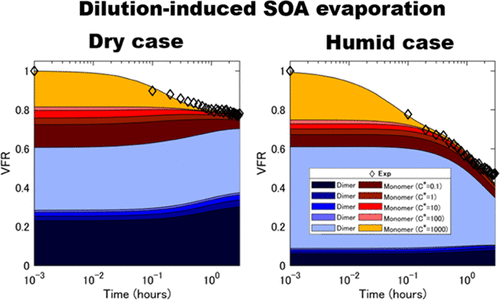当前位置:
X-MOL 学术
›
ACS Earth Space Chem.
›
论文详情
Our official English website, www.x-mol.net, welcomes your
feedback! (Note: you will need to create a separate account there.)
Modeling the Effects of Dimerization and Bulk Diffusion on the Evaporative Behavior of Secondary Organic Aerosol Formed from α-Pinene and 1,3,5-Trimethylbenzene
ACS Earth and Space Chemistry ( IF 2.9 ) Pub Date : 2020-09-26 , DOI: 10.1021/acsearthspacechem.0c00106 Yu Morino 1 , Kei Sato 1 , Shantanu H. Jathar 2 , Kiyoshi Tanabe 1 , Satoshi Inomata 1 , Yuji Fujitani 1 , Sathiyamurthi Ramasamy 1 , Christopher D. Cappa 3
ACS Earth and Space Chemistry ( IF 2.9 ) Pub Date : 2020-09-26 , DOI: 10.1021/acsearthspacechem.0c00106 Yu Morino 1 , Kei Sato 1 , Shantanu H. Jathar 2 , Kiyoshi Tanabe 1 , Satoshi Inomata 1 , Yuji Fujitani 1 , Sathiyamurthi Ramasamy 1 , Christopher D. Cappa 3
Affiliation

|
Volatility determines the gas–particle partitioning of organic compounds. Volatility is thus a key property needed to understand the behavior of organic aerosol (OA) in the atmosphere. Various studies have been conducted to experimentally measure and numerically simulate distributions of OA volatility. The observed OA evaporation rates have generally been slower than the rates assuming instantaneous gas–particle equilibrium and volatility estimated from secondary organic aerosol (SOA) formation experiments. Particle-phase diffusion and/or low-volatility compounds, such as oligomers and highly oxygenated molecules, could limit the evaporation of OA, though the relative contributions of these factors are still uncertain. In this study, we conducted model simulations using a volatility basis set framework with the consideration of kinetic gas–particle partitioning, formation and dissociation of dimers, and particle-phase diffusion to reproduce observed evaporative behaviors of SOA formed from α-pinene ozonolysis and 1,3,5-trimethylbenzene (TMB)/NOx photooxidation. Based on simulations constrained by various volatility distributions derived from chemical analysis or heating experiments, we found that both dimerization and slow particle-phase diffusion contributed to the observed slow evaporation under dry conditions. In contrast, particle-phase diffusion did not practically inhibit SOA evaporation under humid conditions. The similarity of the fitted parameters, including dimer formation/dissociation rates and bulk diffusivity, for SOA from α-pinene and 1,3,5-TMB under dry conditions suggested that these processes are important for both monoterpene and aromatic SOA. Evaporation rates of SOA from α-pinene in this study were slower than the rates reported in previous experimental studies. This difference could be partly explained by differences in the experimental setups, including the treatment of organic vapors.
中文翻译:

模拟二聚和本体扩散对由α-P烯和1,3,5-三甲基苯形成的次级有机气溶胶蒸发行为的影响
挥发性决定了有机化合物的气体-颗粒分配。因此,挥发性是了解大气中有机气溶胶(OA)行为所需的关键特性。已经进行了各种研究来实验测量和数值模拟OA挥发性的分布。观察到的OA蒸发速率通常比假设瞬时气体-颗粒平衡和挥发性的速率要慢,该速率是根据二次有机气溶胶(SOA)形成实验估算的。颗粒相扩散和/或低挥发性化合物(例如低聚物和高度氧化的分子)可能会限制OA的蒸发,尽管这些因素的相对贡献仍不确定。在这个研究中,X光氧化。基于受化学分析或加热实验得出的各种挥发性分布限制的模拟,我们发现二聚化和缓慢的颗粒相扩散均有助于在干燥条件下观察到的缓慢蒸发。相反,在湿润条件下,颗粒相扩散实际上并未抑制SOA的蒸发。在干燥条件下,来自α-pine烯和1,3,5-TMB的SOA的拟合参数(包括二聚体形成/解离速率和体积扩散系数)的相似性表明,这些过程对于单萜和芳族SOA都是重要的。在这项研究中,α-pine烯中SOA的蒸发速率比以前的实验研究中报道的速率慢。这种差异可以部分归因于实验设置的差异,
更新日期:2020-11-19
中文翻译:

模拟二聚和本体扩散对由α-P烯和1,3,5-三甲基苯形成的次级有机气溶胶蒸发行为的影响
挥发性决定了有机化合物的气体-颗粒分配。因此,挥发性是了解大气中有机气溶胶(OA)行为所需的关键特性。已经进行了各种研究来实验测量和数值模拟OA挥发性的分布。观察到的OA蒸发速率通常比假设瞬时气体-颗粒平衡和挥发性的速率要慢,该速率是根据二次有机气溶胶(SOA)形成实验估算的。颗粒相扩散和/或低挥发性化合物(例如低聚物和高度氧化的分子)可能会限制OA的蒸发,尽管这些因素的相对贡献仍不确定。在这个研究中,X光氧化。基于受化学分析或加热实验得出的各种挥发性分布限制的模拟,我们发现二聚化和缓慢的颗粒相扩散均有助于在干燥条件下观察到的缓慢蒸发。相反,在湿润条件下,颗粒相扩散实际上并未抑制SOA的蒸发。在干燥条件下,来自α-pine烯和1,3,5-TMB的SOA的拟合参数(包括二聚体形成/解离速率和体积扩散系数)的相似性表明,这些过程对于单萜和芳族SOA都是重要的。在这项研究中,α-pine烯中SOA的蒸发速率比以前的实验研究中报道的速率慢。这种差异可以部分归因于实验设置的差异,











































 京公网安备 11010802027423号
京公网安备 11010802027423号